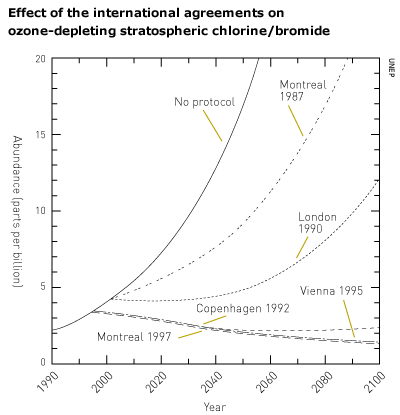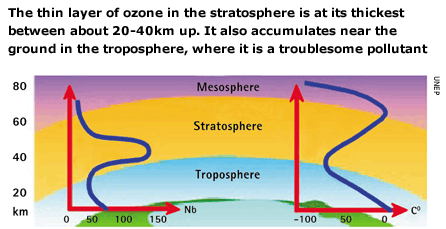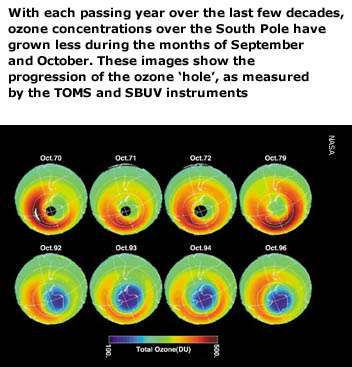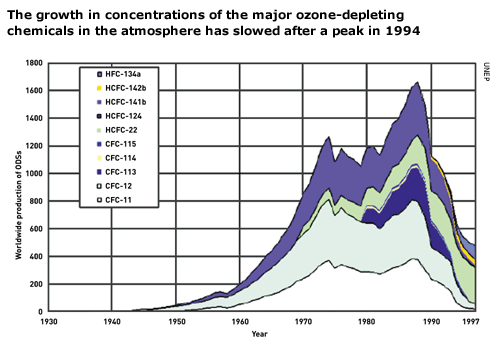 |
|||||
|
The Ozone layer – catastrophe averted? The big issue Ozone (O3) is very rare in our atmosphere, averaging about three molecules of ozone for every 10 million air molecules. Although it represents only a tiny fraction of the atmosphere, ozone is crucial for life on Earth. Close to Earth in the troposphere (the atmospheric layer from the surface up to about 10 km), ozone is a harmful pollutant that causes damage to lung tissue and plants. Most ozone (about 90%) resides in the stratosphere (a layer of the atmosphere between 10 and 40 km above us), where it acts as a shield (strongest at about 25km altitude on average) to protect Earth's surface from the sun's harmful ultraviolet radiation (UV-B), filtering out the high energy radiation below 0.29 µm and allowing only a small amount to reach the Earth’s surface. The ozone in this region is commonly known as the ozone layer. The consequences of damage to this protective layer, and subsequent increases in UV-B radiation include risks of eye damage, skin cancer, and adverse effects on marine and plant life. Throughout the 1970’s and 1980’s, scientists began first to suspect, and then to detect, a steady thinning of the ozone layer - accompanied by increases in the amount of UV-B reaching the Earth’s surface. Scientific concern turned to public alarm when, in 1985, the British Antarctic Survey announced the detection of the first Antarctic ozone ‘hole’ – a sharp decline in stratospheric ozone concentrations over most of Antarctica for several months during the southern hemisphere spring; subsequent studies using satellite data recorded depleting ozone levels over Antarctica growing worse with each passing year. It is now known that the ozone layer over Antarctica thins to between 40% and 55 % of its pre-1980 level with up to 70% deficiency in short time periods, and at some altitudes, ozone destruction is almost total. In September 1998, the Antarctic ozone hole reached a record size of 25 million km2, or two and half times the size of Europe. Moreover, there is the potential of ozone losses occurring in the Arctic. Recently observed Arctic ozone losses have reached levels that are becoming comparable to Antarctic losses. The large Arctic losses observed over the last decade cannot be explained adequately by current atmospheric models. This inability to quantitatively explain present-day ozone losses undercuts the ability to predict ozone losses and, ultimately, ozone recovery in a future atmosphere containing increased concentrations of greenhouse gases.
The response The scientific evidence, accumulated over several decades by the international research community, showed that human-produced chemicals were responsible for the observed depletions of the ozone layer. These ozone-depleting substances, such as halocarbons or chlorofluorcarbons (CFCs) contain various combinations of the chemical elements chlorine, fluorine, bromine, carbon and hydrogen. Substances like CFCs had grown to be extremely popular for use as coolants, solvents, sterilants, and aerosol propellants, amongst other applications. When released into the lower atmosphere, through the use of an aerosol spray for example, they diffuse up into the stratosphere and react in a process which involves destruction of ozone molecules. Faced with the strong possibility that CFCs and similar compounds could cause serious ozone depletion, policy makers from around the world signed the Montreal Protocol treaty in 1987, limiting CFC production and usage. By 1992, the growing scientific evidence of ozone loss prompted diplomats to strengthen the Montreal Protocol. The revised treaty called for a complete phase out of CFC production in developed countries by 1996. As a result, most CFC concentrations are slowly decreasing around the globe – with production having fallen by 95% in industrialised countries. 
The latest research suggests that the Montreal Protocol is working. The abundance of ozone-depleting substances in the lower atmosphere peaked in 1994 and has now started to decline. As a result, the ozone layer is expected to recover slowly over the next 50 years.
The importance of Earth observation satellites Since the 1920's, ozone has been measured by ground-based instruments. Scientists place instruments at locations around the globe to measure the amount of ultraviolet radiation getting through the atmosphere at each site. From these measurements, they calculate the concentration of ozone in the atmosphere above that location. These data, although invaluable for learning about ozone, are not able to provide an adequate picture of global ozone concentrations. The amount and distribution of ozone molecules in the atmosphere varies greatly over the globe, and scientists observing ozone fluctuations over just one spot could not know whether a change in local ozone levels meant an alteration in global ozone levels, or simply a fluctuation in the concentration over that particular spot. Satellites have given scientists the ability to overcome this problem because they provide a picture of what is happening daily over the entire Earth. 
Satellite observations of atmospheric ozone date back to the late 1970’s, to the launch of the TOMS (Total Ozone Mapping Spectrometer) and SBUV (Solar Backscatter Ultraviolet) instruments. These instruments have since been complemented by long term measurements by US and European satellite series, and by missions of Russia and Japan. Re-analysis of the early satellite data proved instrumental in providing the scientific evidence necessary to support the case for the international political response which emerged in the 1980’s, and more recent missions have proved essential in long term mapping of the ozone depletion trends, and in gathering the data required for a better understanding of the underlying atmospheric science. Increasingly, satellite instrumentation is capable of more advanced measurements of ozone parameters – such as profiles of ozone concentration through the atmosphere (as opposed to just the total ‘column’ amount), as well as information on a range of other trace gases which help ozone chemistry studies. Such data is now being used as the basis for operational information services for the public and science community alike. The UV Forecasting service of the Royal Netherlands Meteorological Institute (KNMI) – in collaboration with the European Space Agency (ESA) - is one example; this uses data from ESA satellites to provide ozone profile and UV measurement indices within hours of collection, and can cover the entire globe within just 3 days. Such information is becoming a routine and essential part of our daily diet of weather information as awareness increases of the dangers of exposure to excessive sun.
Future challenges Although not yet conclusive, there are some symptoms of a very slow recovery of the ozone layer – and that a global environmental catastrophe may have been averted. The detection of the damage, its characterisation by Earth observation satellites and supporting ground stations, and mobilisation of a relatively swift political response might be regarded as a scientific success story. Yet there is no room for complacency. The trend to recovery in the ozone layer is both slow, recent, and inconclusive. Atmospheric science is complex and much remains to be learned about the processes that affect ozone. To create accurate models, scientists must study simultaneously all of the factors affecting ozone creation and destruction. Moreover, they must study these factors continuously, over many years, and over the entire globe. Earth observation satellites will provide the main source of information for these studies. Part III of this document summarises the various plans of the world’s space agencies over the coming decades in providing satellite missions in support of this global responsibility. To be effective, data from these missions must be inter-comparable, and provide the precision, consistency, and long-term accuracy required for scientific studies of climate. Earth observation satellites must also rise to a number of new and emerging dimensions to the ozone issue, including:
Improved measurement capabilities in the troposphere, and higher resolution profiling capabilities of planned satellite instruments are expected to contribute significantly to study of these problems. The necessary coordination of the relevant satellite missions will be undertaken by CEOS including through their participation in the Integrated Global Atmospheric Chemistry Observations (IGACO) Theme of the IGOS Partnership – which aims to integrate both space-based and in-situ measurements of key atmospheric parameters. |
||
|
||


